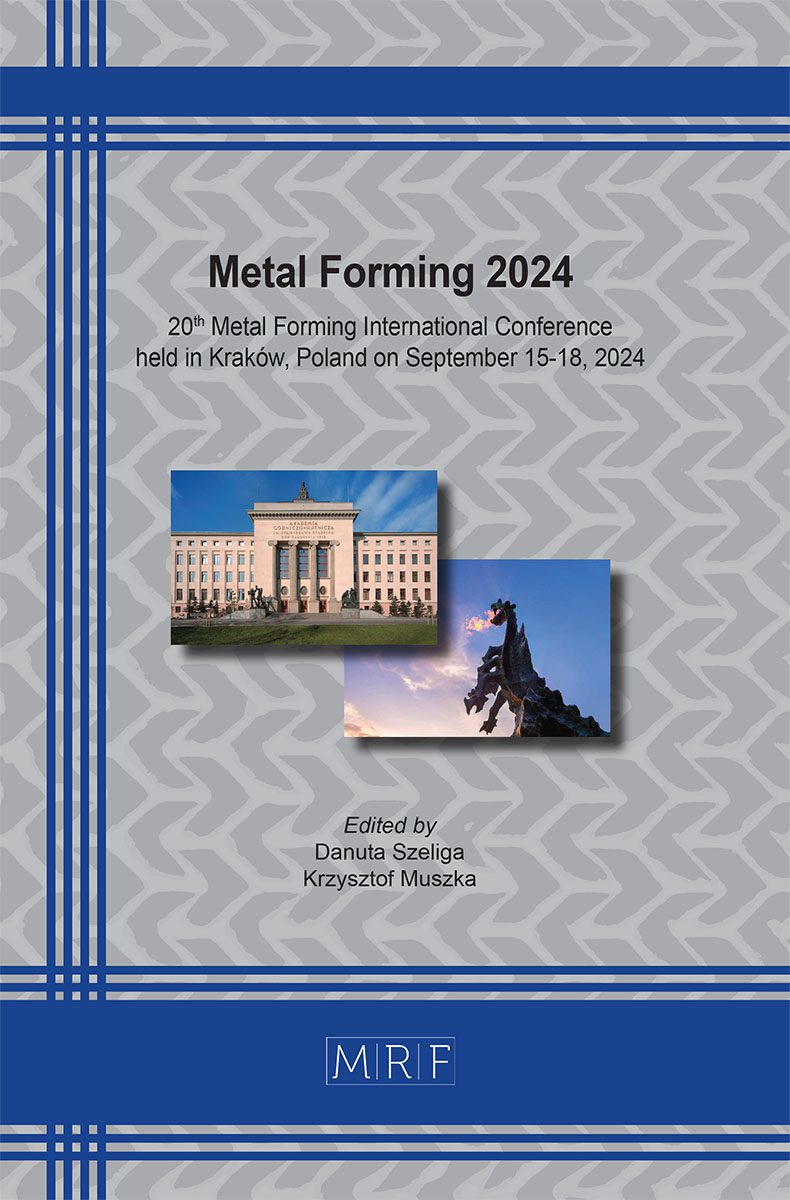–
Multi-scale numerical modeling of the multi-pass rolling texture evolution by using crystal plasticity and finite element method
BYRSKA-WÓJCIK Dorota, WIERZBANOWSKI Krzysztof, WRÓBEL Mirosław, BŁONIARZ Remigiusz
download PDFAbstract. The finite element method (FEM) combined with the crystal plasticity (CP) model was used to predict crystallographic texture evolution during multi-pass asymmetric rolling of the polycrystalline aluminum with tilted entry into the rolling gap. The FEM macro-scale model of the rolling process with various asymmetry was performed using Abaqus commercial software. The asymmetry was introduced by difference in the diameters of cooperating rolls and various tilt angles of the rolled bar entry into the rolling gap. Predicted stress distribution over sample volume was used as the boundary conditions in the crystal plasticity meso-scale model of the plastic deformation. The CP meso-scale model developed by Leffers and Wierzbanowski [1], [2] was used as a post-processing procedure. The predicted evolution of the rolling texture distribution on the rolled bar thickness turned out to be in good agreement with that measured for specimens rolled with the same parameters as the ones used for modeling. Impact of the rolling parameters on the texture evolution was found.
Keywords
Multiscale Model, Multi-Pass, Finite Element Method, Crystal Plasticity, Asymmetric Rolling, Aluminum, Texture, Product Homogeneity
Published online 9/15/2024, 9 pages
Copyright © 2024 by the author(s)
Published under license by Materials Research Forum LLC., Millersville PA, USA
Citation: BYRSKA-WÓJCIK Dorota, WIERZBANOWSKI Krzysztof, WRÓBEL Mirosław, BŁONIARZ Remigiusz, Multi-scale numerical modeling of the multi-pass rolling texture evolution by using crystal plasticity and finite element method, Materials Research Proceedings, Vol. 44, pp 606-614, 2024
DOI: https://doi.org/10.21741/9781644903254-65
The article was published as article 65 of the book Metal Forming 2024
![]() Content from this work may be used under the terms of the Creative Commons Attribution 3.0 license. Any further distribution of this work must maintain attribution to the author(s) and the title of the work, journal citation and DOI.
Content from this work may be used under the terms of the Creative Commons Attribution 3.0 license. Any further distribution of this work must maintain attribution to the author(s) and the title of the work, journal citation and DOI.
References
[1] K. Wierzbanowski, M. Wroński, T. Leffers, FCC rolling textures reviewed in the light of quantitative comparisons between simulated and experimental textures, Crit. Rev. Solid State Mater. Sci. 39 (2014) 391–422. https://doi.org/10.1080/10408436.2014.899485
[2] S. Wronski, M. Wrobel, A. Baczmanski, K. Wierzbanowski, Effects of cross-rolling on residual stress, texture and plastic anisotropy in f.c.c. and b.c.c. metals,Mater. Charact. 77 (2013) 116–126. https://doi.org/10.1016/j.matchar.2013.01.005
[3] A. Uniwersał, M. Wróbel, K. Wierzbanowski, S. Wroński, A. Baczmański, Mechanical and microstructural characteristics of polycrystalline copper rolled asymmetrically to a high deformation level, Mater. Charact. 148 (2019) 214–223. https://doi.org/10.1016/j.matchar.2018.12.017
[4] A. Uniwersał, M. Wroński, M. Wróbel, K. Wierzbanowski, A. Baczmański, Texture effects due to asymmetric rolling of polycrystalline copper, Acta Mater. 139 (2017) 30–38. https://doi.org/10.1016/j.actamat.2017.07.062
[5] M.Y. Amegadzie, D.P. Bishop, Effect of asymmetric rolling on the microstructure and mechanical properties of wrought 6061 aluminum, Mater. Today Commun. 25 (2020) 101283. https://doi.org/10.1016/j.mtcomm.2020.101283
[6] A. Uniwersał, M. Wróbel, K. Wierzbanowski, S. Wroński, M. Wroński, I. Kalemba-Rec, T. Sak, B. Bacroix, Microstructure, texture and mechanical characteristics of asymmetrically rolled polycrystalline copper, Mater. Charact. 118 (2016) 575–583. https://doi.org/10.1016/j.matchar.2016.07.004
[7] S. Wroński, K. Wierzbanowski, B. Bacroix, M. Wróbel, M. Wroński, Crystallographic textures variation in asymmetrically rolled steel, Mater. Sci. Forum 638–642 (2010) 2811–2816. https://doi.org/10.4028/www.scientific.net/MSF.638-642.2811
[8] S. Wroński, K. Wierzbanowski, B. Bacroix, T. Chauveau, M. Wróbel, Effect of asymmetric rolling on mechanical characteristics, texture and misorientations in ferritic steel, J. Cent. South Univ. 20 (2013) 1443–1455. https://doi.org/10.1007/s11771-013-1633-5
[9] H. Wang, Y. Li, G. Xu, H. Tang, Y. Wang, J. Li, B. Li, T. Zhang, W. Yu, Y. Wang, Y. Liang, The effect of asymmetric rolling on the microstructure and properties of Al–Cu–Li–TiC/TiB2 alloys, Mater. Sci. Eng. A 897 (2024) 146333. https://doi.org/10.1016/j.msea.2024.146333
[10] “United States Patent US008250895B2,” Aug. 2008.
[11] A. Uniwersał, M. Wróbel, K. Wierzbanowski, S. Wroński, A. Baczmański, Rolling asymmetry effects on recrystallization process and on properties and microstructure of annealed copper, Mater. Charact. 153 (2019) 136–147. https://doi.org/10.1016/j.matchar.2019.05.001
[12] M. Wroński, K. Wierzbanowski, M. Wróbel, S. Wroński, B. Bacroix, Effect of rolling asymmetry on selected properties of grade 2 titanium sheet, Met. Mater. Int. 21 (2015) 805–814. https://doi.org/10.1007/s12540-015-5094-2
[13] K. Wierzbanowski, M. Wroński, A. Baczmański, B. Bacroix, P. Lipinski, A. Lodini, Problem of lattice rotation due to plastic deformation. Example of rolling of F.C.C materials, Arch. Metall. Mater. 56 (2011) 575–584. https://doi.org/10.2478/v10172-011-0061-5
[14] E. Schmid, W. Boas, Kristallplastizität. Springer Berlin Heidelberg, 1935.
[15] G. Wassermann, H.‐J. Bunge. Mathematische Methoden der Texturanalyse Akademie‐Verlag Berlin 1969, 330 Seiten Geb. M 68.–, Krist. und Tech. 5 (1970) K23–K23. https://doi.org/10.1002/crat.19700050319












